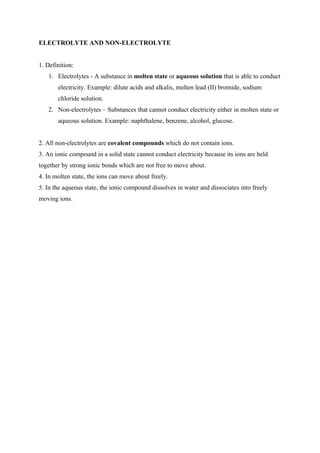Melden
Teilen

Empfohlen
Empfohlen
Weitere ähnliche Inhalte
Was ist angesagt?
Was ist angesagt? (20)
Andere mochten auch
Andere mochten auch (16)
Ähnlich wie Electrolyte
Ähnlich wie Electrolyte (20)
Properties of Compounds - Ionic, Covalent and Metallic

Properties of Compounds - Ionic, Covalent and Metallic
compounds are classified as based on the water so.pdf

compounds are classified as based on the water so.pdf
a. formic acid (it has more polar components than cyclohexane, inclu.pdf

a. formic acid (it has more polar components than cyclohexane, inclu.pdf
Properties of covalent substances, metals and ionic compounds

Properties of covalent substances, metals and ionic compounds
Electrolyte
- 1. ELECTROLYTE AND NON-ELECTROLYTE 1. Definition: 1. Electrolytes - A substance in molten state or aqueous solution that is able to conduct electricity. Example: dilute acids and alkalis, molten lead (II) bromide, sodium chloride solution. 2. Non-electrolytes – Substances that cannot conduct electricity either in molten state or aqueous solution. Example: naphthalene, benzene, alcohol, glucose. 2. All non-electrolytes are covalent compounds which do not contain ions. 3. An ionic compound in a solid state cannot conduct electricity because its ions are held together by strong ionic bonds which are not free to move about. 4. In molten state, the ions can move about freely. 5. In the aqueous state, the ionic compound dissolves in water and dissociates into freely moving ions.